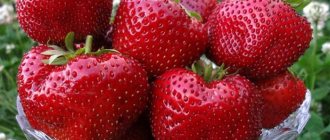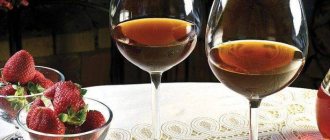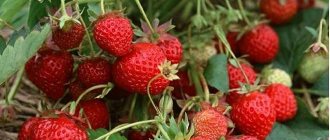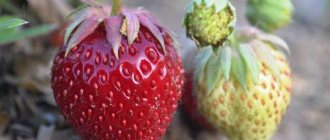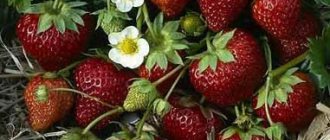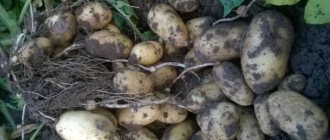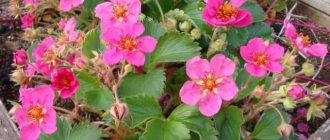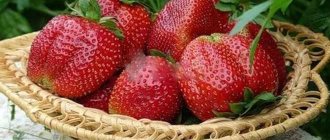Loading…
Loading…
Strawberries are one of the most favorite plants among gardeners, producing tasty and aromatic berries. Every year, thanks to the efforts of professionals and amateur breeders, new varieties of strawberries appear. Despite this, there are varieties that have been favorites among numerous summer residents and farmers for several decades, producing stable yields. Strawberry Queen Elizabeth and its successor Queen Elizabeth 2 are the most popular remontant varieties.
History of selection
It is precisely established that the Elizabeth strawberry was created in Great Britain. The Englishman Ken Muret developed it in the late 90s, when the main advantages of garden strawberries were considered to be fruits that were large in size and juicy. The variety became the basis for obtaining an improved strawberry called Elizabeth 2.
Garden strawberries Elizaveta are early-ripening varieties with large fruits and can be grown in greenhouses and open ground.
Description and characteristics of garden remontant strawberries Queen Elizabeth
Rarely a summer cottage can do without a strawberry bed
Garden strawberry is a very common berry. It’s rare that a summer cottage is complete without strawberry beds. But for some reason, such a popular crop is often called by the name of another berry - strawberry.
Why are garden strawberries called strawberries?
The Strawberry genus includes up to 100 plant species. These are wild wild strawberries, green strawberries, nutmeg strawberries, Bukhara strawberries, Chilean strawberries, Virginia strawberries and others. The crossing of the last two species gave birth to the large-fruited pineapple strawberry, from which all modern cultivated varieties came.
In Russia, wild strawberries were called strawberry berries (grows near the ground), and green strawberries (steppe, polunitsa) were called strawberries (the shape of the berry is like a tuber); Strawberries were also called nutmeg (musk) strawberries, but they are much less common in nature, although they have been grown in Russian gardens since the 17th century.
When, at the end of the 19th century, garden large-fruited strawberries were brought to Russia from abroad and they began to be grown en masse instead of musk strawberries (strawberries), the name strawberry was inherited by inheritance - this was more familiar to people. The situation was further complicated by the fact that after the name of one of the first varieties of garden strawberries, long forgotten, they began to call it Victoria. In the villages, until recently, one could hear: “Strawberries are in the field, and Victoria is in the garden.”
So, both strawberries and strawberries grow wild in our country. Both are good, but each has its own taste and appearance.
Strawberries on the left, wild strawberries on the right
The photo clearly shows the differences in the shape and color of the berries. Garden remontant strawberries Queen Elizabeth are far behind their wild-growing relatives in terms of yield, berry size, and ability to bear fruit almost from spring until the snow.
The royal berry has a royal size
So, let's remember: strawberries have not been grown in our gardens since the 19th century, unless they were brought from the forest by a lover of true strawberry taste and aroma. But this is in theory, but in real life they may look at you with surprise at the market if you ask to weigh large-fruited garden strawberries - this is how the name strawberry has grown together with it.
Varieties Queen Elizabeth and Elizabeth 2
In our country, there are two similar varieties of remontant garden strawberries with similar names - Queen Elizabeth and Elizabeth 2. They have a lot in common in their basic characteristics. As stated in RuNet, the remontant variety of garden strawberries, Koroleva Elizaveta, appeared in Russia at the turn of the 20th and 21st centuries. Its author is considered to be the famous English breeder Ken Muir. But it seems that strawberries received this name already in Russia: on the website of Ken Muir, who died in 2011, there is no such name among the 21 varieties of strawberries offered for sale.
But the origin of Elizabeth 2 is connected with research and production in the Rostov region, which was one of the first in Russia to start working with Queen Elizabeth. And in 2000, among the plantings, several bushes were noticed, distinguished by the special size of the berries, increased shoot-forming ability and a longer fruiting cycle, and selection work was continued with them. In 2004, the variety was included in the official State Register of breeding achievements approved for use.
Already at the end of April, residents of the southern regions can treat themselves to remontant strawberries Elizaveta 2
Table: comparative description of the varieties Koroleva Elizaveta and Elizaveta 2
| Characteristic | Queen Elizabeth | Elizabeth 2 |
| Ripening time | from early June to September. | From mid-May to September. |
| Productivity per bush, kg | up to 2. | up to 2. |
| Appearance of bushes | Semi-spreading. | Erect, semi-spreading, larger. |
| Appearance of berries | Scarlet, dense, shiny. | Dark scarlet, dense, shiny. |
| Berry weight, g | 20–40, maximum and very rarely 100. | 30–50, maximum and very rarely 125. |
| Tasting assessment | 4,4. | 4,7. |
| Vegetative capacity | Average. | High. |
| Lifespan, years | 2. | 3. |
These new varieties of remontant garden strawberries are day-neutral varieties.
In day-neutral remontant varieties, flower primordia are formed regardless of the length of daylight hours, so they bear fruit almost continuously. In ordinary remontant varieties, the interval between summer and autumn fruiting can reach up to 8 weeks.
Want to treat yourself to strawberries in winter? Root the mustaches in pots and transfer them to the windowsill for the winter. There they can be grown, while at the same time harvesting a home harvest.
As can be seen from the table, the characteristics are very similar, but in general the Elizabeth 2 variety looks preferable.
Photo gallery: royal berries
Queen Elizabeth has juicy scarlet berries
Elizabeth 2 berries are darker than Queen Elizabeth's
Berries pull Queen Elizabeth's stems to the ground
Elizabeth 2 pleases her owners with a bountiful harvest
Berries of both varieties can be collected until late autumn
Video: Queen Elizabeth's Harvest
Table: advantages and disadvantages of varieties
| Advantages | Flaws |
| High yield. | Requirement for regular feeding. |
| Long fruiting period. | |
| Excellent taste and beautiful appearance of the berries. | |
| Winter hardiness and drought resistance. | |
| Good transportability, allowing you to grow berries for sale. | |
| Resistance to fungal diseases. |
Description of the variety
A detailed description of the variety will help determine the characteristics of the Queen Elizabeth strawberry, its advantages and disadvantages. The main characteristics of the culture are presented in the table:
| No. | Characteristic | Index |
| 1 | Maturation | Early ripening |
| 2 | Fruiting | Remontant |
| 3 | Fruit weight | On average they weigh 30-60 g, maximum - 90 g |
| 4 | Appearance | Bright red with a glossy sheen |
| 5 | Taster rating on a 5-point scale | 4,7 |
| 6 | Productive cycle duration | No more than 2 years |
| 7 | Productivity per season per square meter, kg | 2.8-4.5 in open ground, in greenhouses - up to 10. |
Elizabeth is practically not susceptible to infection by fungi, etc.
Strawberry Elizaveta bears fruit up to 4 times per season. From one bush you can collect up to 4.5 kilograms of juicy berries.
Bushes
The bushes are large in size, with concave leaves. The peculiarity of the leaf blades is green, but light color with shine. Remontant strawberry plants are spreading and strong. The leaf blade is distinguished by a border with sharp teeth. During vegetative growth, bushes form up to 5 tendrils. Up to 3 rosettes are formed on each lash. Plants spend most of their energy on producing juicy fruits. On July rosettes, the harvest ripens in August.
Flowers and berries
According to the description, the flower stalks do not spread along the ground and are located at the level of the leaves. They are strong and standing, which prevents contact of the berries with the soil. There are no empty flowers, because the flowers are bisexual, semi-double or five-petaled.
The strawberry skin is red with a glossy sheen. The juicy but dense pulp has a distinct aroma. Summer fruits are characterized by a sweet, honey-like taste. Fruits obtained in spring or autumn are sour.
Features of berries:
- The fruits have the same shape and size.
- The average fruit weight can be 30-60 g. If you follow the rules of agricultural technology, you can get berries weighing 90 g.
- Towards the end of the season the pulp becomes denser.
- The shape of the berries changes during the ripening process. Initially the fruits are round-oval. As they ripen, they acquire a lumpy, cone-shaped shape. The elongated tip may remain white on mature strawberries.
- It is recommended to grow Elizabeth as an annual (biennial) plant.
When forming the first harvest, the appearance of comb-shaped berries is possible.
Elizabeth is considered universal. It is consumed fresh, dried, used for preservation, added to desserts, fresh juices, etc. The fruits can be frozen, because after thawing they retain their shape.
Juicy fruits are perfect for making desserts, baking and home canning.
Productivity and ripening time
The fruiting period lasts almost continuously. When growing Queen Elizabeth strawberries without additional shelter, the bushes bloom and bear fruit for 6 months, in greenhouses - 10 months.
The first fruiting occurs at the end of May - beginning of July. Then the bushes gain strength and bloom. The break between waves of fruiting is 14 days.
The early onset of fruiting is explained by the preservation of flower stalks with buds on the bushes during the winter. The process of flowering and fruit formation proceeds faster.
The next harvest ripens in July. Subsequent fruiting occurs in August. In warm weather, another wave has time to mature. Fruiting lasts until cold weather. In spring, one bush produces up to 700 g, in summer and autumn - about 2 kg.
The berries are large with dense pulp and have a rich strawberry aroma and dessert taste.
Drought and frost resistance
Elizabeth is considered a frost-resistant remontant variety. Plants can withstand temperatures down to -23 °C without additional shelter. However, it is not recommended to leave the soil cracked and dry before frost. It is recommended to water the soil around the bushes. Otherwise, the plant roots will freeze.
If formed buds remain on the peduncles, to protect them during cold weather it is necessary to additionally cover the bushes.
During drought, plants need to be well watered. The ideal option is to install drip soil moisture systems. Otherwise, the berries will not absorb juice; they are crushed.
When the temperature rises to critical levels, the growth of the ovaries slows down.
To avoid damage to strawberries by gray rot upon contact with soil, it is recommended to mulch the plantings with straw, pine needles, and sawdust.
Transportability
Elizaveta strawberries are grown by gardeners for home canning and for sale. During transportation, it does not lose its appearance and retains its shape. The fruits can be stored for three days, because after harvesting their surface remains dry.
Reviews
Maria, 62 years old, Krasnogorsk district
Last fall, I picked the last harvest of berries from “Queen Elizabeth” in the OG on November 6! Some of them were nailed down by frost, but many remained intact, without rot. Interestingly, flowers and berries can tolerate frosts down to −4-6 degrees even without covering the bushes. The strawberries are wonderful - large, clean and tasty.
Dina, 44 years old, Irkutsk
I ordered this variety from the Abbeker company. The harvest came in the first season after planting, and it was excellent. We ate fresh berries all summer and made jam. The taste is simply delicious: sweet, slightly honeyed, and the aroma is like wild strawberries! I will definitely leave mustaches for my seedlings.
Elena, 32 years old, Magnitogorsk
I don’t know what my parents bought, Queen Elizabeth strawberry seeds, or mustaches, but last summer we were left without strawberries. Either they did something wrong, or the seller lied.
Suitable region and climate
Strawberries of the Elizabeth variety are a variety of crop that can bear fruit in any climatic zone. Without greenhouses, strawberries feel good in the regions of the middle zone. Here you can harvest throughout the season.
In southern climatic zones, strawberries do not bear fruit with the onset of a hot period. The process resumes when the heat goes away and continues until cold weather.
Garden strawberries of the Elizabeth variety are suitable for amateur and industrial cultivation in any region.
Landing
For cultivation, choose a well-lit area with low groundwater levels. All plants in the garden should receive enough light. Therefore, it is necessary to plant them in rows. In this case, the plantings are located in the direction from east to west. The site should be level or slightly sloping. Lowlands should be avoided, as such places are damp. It is necessary to prepare the ridge in the fall or 30 days before planting in the spring. The soil is dug up and fertilizer is applied: 7 kg per 1 m2.
It is necessary to plant seedlings in the spring, when all frosts have stopped, or in early September.
Planting stages:
- Dig a hole, the depth of which is at least 10 cm.
- Straighten the roots of the seedlings and place the sprout in the center of the prepared depression.
- Sprinkle with soil and water. In this case, it is necessary to monitor the planting depth. The soil should not cover the outlet. Otherwise, it will begin to rot and the plant will die.
Only healthy seedlings are used as planting material. The foliage should be free of dents, dots, and stains. Seedlings begin to bear fruit from the first year.
It is recommended to plant seedlings in the spring after stable warming, when the top layer of soil warms up to 15˚C.
Growing and care
It is recommended to plant Queen Elizabeth strawberries in areas of fertile soil, which include loamy, sandy loam and neutral soils. Requires moderate humidity and lighting. Excess water in the soil negatively affects the berries. They become watery and tasteless.
The remontant variety requires timely application of fertilizing. Nitrogen, potassium, and phosphorus mixtures are suitable. You can add organic compounds, such as chicken droppings, yeast, manure, etc. Regular but moderate watering is equally important.
To get a good harvest, it is necessary to plant plants on fertile soils. In the absence of the required nutrition, the berries become smaller.
Watering
The Elizabeth variety loves moisture. However, you should not overwater the plants. If the season is rainy, additional watering is not required.
In dry weather, it is necessary to irrigate the bushes with settled water. The soil should be moistened every 2-3 days. Water should not be on top of the leaves, but under the roots. Otherwise, the above-ground part of the plant may be affected by the disease.
The soil under the bushes may dry out, but at a depth of 3-5 cm it should remain moist. To determine the need for watering, dig up a ridge, take a handful of soil and clench your fist. If a lump has not formed, it’s time to take up the watering can. You can determine the lack of moisture by the condition of the bushes: limp, drooping leaves.
Before flowering, drip irrigation or sprinkling is recommended. During flowering and fruiting, it is worth making grooves between the rows and pouring water into them.
During the period of fruiting and flowering, it is recommended to avoid watering the foliage to avoid damage to the crop and the development of fungal diseases.
Loosening and weed control
It is necessary to remove weeds from the plantings that take away nutrition from the strawberry bushes. Weeds can cause insect attacks. The row spacing can be treated with a soda tool. Grass growing near the strawberry roots will have to be removed manually.
To provide oxygen to the roots, it is recommended to loosen the soil around the bushes after each watering. The procedure should be carried out carefully. Otherwise, you can damage the roots located close to the soil surface. To maintain moisture around the plants, you can sprinkle the soil with peat mulch.
Removing a mustache
Repairing strawberries regularly produce lashes. When whiskers appear on strawberry bushes, they must be removed. It is forbidden to pull out the whips. You need to remove it with garden shears. There is no need to process cut areas.
To increase productivity, it is necessary to trim the mustache and dry leaves in a timely manner.
Preparing for winter
In order for strawberries of the Elizaveta variety to overwinter well, you need to:
- After harvesting the last crop, water the plantings generously. The procedure is carried out approximately 30 days before the onset of the first frost. After this, the soil under the bushes is no longer moistened.
- Put the beds in order: remove dried leaves, weeds, diseases and pests of berries.
- In autumn, remove only the lower dry and diseased leaves. Pruning is carried out in the spring.
- Rake the soil towards the bushes, forming hills. Cover the root collars with soil. It is not recommended to loosen the plantings. Otherwise, the damaged roots will not have time to recover and the plant will die.
- Sprinkle with mulch consisting of dry peat or humus. Pine needles will do. The thickness of the layer is 5 cm. It is forbidden to use straw, because rodents live in it and can damage the roots of plants. It is not advisable to use fallen leaves. It is soaked in moisture and rotting.
- Cover the beds with breathable material: agrotex, spunbond, dutrasil. The covering should be pulled over supports or arches. This measure is relevant in winters with little snow or when severe frosts are expected. When there is heavy snowfall, it is recommended to shovel snowdrifts onto the strawberry beds.
You cannot cover the beds if the weather is warm and sunny. It is necessary to wait until the first frost.
The variety is frost-resistant, but requires additional shelter for the winter in cold regions to preserve the ovaries.
Features of agricultural technology
It's time to talk about growing. Let's start, perhaps, with the first Elizabeth. In agricultural technology it is quite simple and does not require much attention. It is only important to carry out the most standard measures, monitor sufficient soil moisture, and apply fertilizers in a timely manner. It does not require a lot of feeding; two or three per season will be enough. Particular attention should be paid to removing mustaches, since strawberries form them in large quantities. They take over a lot of nutrients, so if their number is not normalized, the berries will become smaller. Do not forget to rejuvenate the plantation in time. For this variety, such an event must be carried out approximately once every 2-3 years, depending on the intensity of use.
Now let’s move on to the intricacies of growing Queen Elizabeth 2. It’s worth saying right away that agricultural technology greatly influences the yield of this strawberry, and it’s up to you how its enormous potential will be revealed.
- Before planting, the area must be properly fertilized. Don't skimp on organic fertilizers to give your plants a good start. At least 7-8 kg of humus is added per 1 square meter, then the area is dug well, the soil is allowed to settle and only then the plants are planted. It is also extremely important to provide seedlings with mineral nutrition from the first days of their life in a new place. When planting, it is advisable to add phosphorus complexes to the soil. In a word, the productivity and health of our remontant depends to a great extent on the fertility of the soil, and it is clearly not worth neglecting the application of fertilizers.
- As for the soil itself, the variety is moderately demanding on its chemical composition, but liming of soils with high acidity is highly desirable.
- The following planting density is recommended - 5-6 plants per 1 square meter. Excessive thickening will lead to reduced yield and reduced berry size.
- Plants are planted according to the following scheme: about 30 cm between plants and 60-70 cm between rows.
- The most important point is to provide Queen Elizabeth 2 with enough fertilizer. Plants need them throughout the entire season; often, foliar feeding is also necessary, which can provide strawberries with “quick” nutrition. Do not skimp on fertilizers, since the quantity of the harvest and its taste largely depend on the abundant, high-quality nutrition.
- The variety is remontant, so the plantation needs to be rejuvenated more often. It is not advisable to use plants for more than two years; with intensive cultivation, the period is reduced to one year. Fortunately, strawberries produce a sufficient number of tendrils and take root well, so there will be no problems with reproduction. By the way, the newly formed mustaches are already able to bear fruit in the first year on a par with the queen cells!
Much has already been said, so let’s briefly summarize all of the above and mention some of the disadvantages of both varieties. Both Queen Elizabeths are beautiful and equally popular. But each has its own characteristics. As for the first, it has excellent taste and fairly high yields, but its fruiting period is short and depends on the length of daylight hours. And of course, she is inferior to Elizabeth 2, who has the same advantages, but multiplied by that same two. It is tastier, more productive, and can bear fruit all year round, but in exchange for such characteristics it requires much more care. Not every gardener is ready to pay so much attention to his strawberries, so the potential of the variety often simply remains undiscovered. But if you take good care of your plants, Queen Elizabeth 2, and her predecessor, will reward you with a truly royal harvest!
Top dressing
Elizabeth requires seasonal care. It is recommended to use nitrogen fertilizer as a top dressing. It is applied in spring and the first half of summer. The ideal option is calcium or sodium nitrate (15-20 g per bush). Nitrogen is a substance that improves the growth of the green part of the plant.
Potassium is required for the development of the root system and strengthening protective functions. Calcium must be added to prevent the soil from absorbing other microelements. The listed components of fertilizers reduce the alkaline index of the soil. Additionally, plants are fed in August.
The use of chlorine-based fertilizers is prohibited.
Organic compounds are suitable for feeding. It is recommended to use rotted manure, humus, and herbal infusions as fertilizer.
Potassium sulfate must be added to the soil in the spring. Fertilizing enhances the protective functions of plants and strengthens the root system, preventing the death of seedlings.
Foliar feeding during flowering
This type of feeding is useful for garden strawberries preparing to bear fruit. You can prepare it yourself:
- In a container, combine manganese (2 g), potassium nitrate (2 g), boric acid (1 g), diluted with warm water. Before use, the mixture must be diluted with a liter of liquid.
- Dilute the ash in boiling water (300 g in 1 l), stir. Leave for 2 hours, filter.
- Dilute pressed yeast in water (1 kg per 5 l). Leave the fertilizing for 24 hours. Spray the bushes with the prepared solution.
Ready-made fertilizers are sold in specialized stores.
Wood ash accelerates metabolic processes and promotes lush flowering, helping plants absorb trace elements and minerals.
Feeding during fruiting
When forming fruits, it is recommended to abandon foliar fertilizers containing inorganic compounds. It is better to use root fertilizers, for example:
- For 10 liters of water, 2 kg of manure (fresh) is required. Mix the ingredients and leave for 3 days. The resulting composition must be diluted with 10 liters of liquid.
- Requires 2 kg of chicken droppings per 10 liters of water. Mix the ingredients, close the container, and leave for 3 days. The result is a concentrated fertilizer. Before use, it must be diluted with water (1 to 10).
Chicken manure is superior in composition to other types of organic matter, as it contains more nitrogen, phosphoric acid, potassium and calcium.
Feeding after fruiting
Between ripening and harvest, the crop requires additional nutrition. Feeding is carried out according to the following scheme:
- In June it is necessary to feed with calcium nitrate. A small amount of organic matter will supplement plant nutrition.
- In August, plants should be fertilized with agrofoska and a small amount of organic fertilizers.
- In autumn, plants should be fed with potassium. It is recommended to add organic matter.
After fruiting, it is necessary to fertilize the soil under the strawberry bushes, since the growth and yield of the plantings depends on this.
It is recommended to apply potassium nitrate to the soil during the vegetative growth of plants, during the formation of ovaries, and also after harvesting.
Pests and diseases
Elizabeth is a strawberry that is resistant to many diseases. Plants are practically not affected by brown spot and late blight. Powdery mildew is also not dangerous for bushes. Occasionally, gray rot may appear on the above-ground parts of plants with abundant watering. The main damage to strawberries is caused by insects, including chafer larvae, nematodes, slugs and bedbugs.
May beetle larvae
The most dangerous pests for Elizabeth are the larvae of the cockchafer. They affect the root system of plants, which leads to the death of plantings. To combat insects, you can use Trichopolum. The drug in tablets is crushed and scattered over the beds or under the bushes.
If the damage affects individual plants, it is necessary to water them with an ammonia solution. For this, 1 tsp. The product should be diluted in 1 liter of water. During the season, such treatment is carried out several times. In addition, the substance contains nitrogen, which is necessary for strawberries.
May beetle larvae damage the root system of plants, which makes seedlings vulnerable to pathogens.
Nematodes
Almost invisible worms prefer to settle on stems and roots. Pests feed on plant sap. At the same time, the leaves of the affected bushes are characterized by asymmetry, deformations, thickened veins, shortened petioles, and fragility. Berries may not set. The formed fruits are small and uneven. On the roots of plants you can see small white swellings, like poppy seeds.
To avoid contamination of strawberries, it is recommended to plant nasturtium, marigolds, and calendula near the plantings. Before planting in the ground, the roots of the seedlings must be dipped in a salty solution consisting of 1 liter of water and 30 g of salt for 10-15 minutes. Before planting, rinse with clean water. A solution of Fosdrin and Parathion is also suitable for these purposes.
About once every 3 years, strawberries need to be transplanted to another place. Every 25 days, it is recommended to spray the planting beds with “Fundazol” and “Skora” solution.
In advanced cases, the plants are dug up and destroyed, the beds are covered with covering material and a piece of sulfur is burned under it.
Nematodes are extremely tenacious parasites and can damage not only the root system of plants, but also stems and leaves.
Bedbugs
The presence of bedbugs is determined by the characteristic unpleasant odor, which affects the taste of the fruit. It is impossible to use chemicals when attacking parasites, since many of them are dangerous to humans. For prevention, it is recommended to plant black cohosh between strawberry bushes.
Individually, bugs do not pose a danger to plants, but entire colonies of insects can destroy a crop.
Slugs
Signs of strawberries being damaged by slugs are through holes in the berries, shiny sticky marks on the surface of leaves and fruits.
When fighting parasites, it is not recommended to use metaldehyde-based products. The substance is dangerous for animals and people.
To eliminate slugs, it is necessary to set traps. To do this, dig a container filled with syrup or beer into the ground. You can use cut grapefruit to catch parasites.
To repel pests, strawberry bushes are surrounded with a ring of sawdust, pine needles, dolomite flour, sand, wood ash, and eggshells. Spicy and aromatic herbs can be planted next to the plantings.
To combat slugs in strawberry beds, you can plant aromatic herbs: rosemary, parsley, sage, thyme, lavender, santolins.
Strawberry "Elizabeth": cultivation and care
First of all, you need to choose a sunny and dry place for the plant. You also need to make sure that the bushes are protected from the wind. It is not recommended to plant remontant strawberries “Elizabeth” in lowlands. It grows best on sandy and loamy soils. The plant does not survive in wetlands.
It is also worth paying attention to the acidity of the soil; it should not exceed 6 pH. In order to assess the quality of the land, it is enough to purchase a special electronic gadget.
It is best to plant the crop in the third decade of July or early August. Some people prefer to hold such events in the fall. In this case, you will need to cut off all emerging flower stalks. If severe cold snaps are not expected in the spring, then planting can be postponed until this time of year.
As a rule, uterine bushes and mustaches are used for propagation. In this case, one rosette should have at least 2-3 leaves.
Some people prefer to use Elizabeth strawberry seeds. In this case, the seedlings need to be planted at home and then transferred to open ground.
You need to start caring for the plant at the initial stage. To do this, before planting, you need to dig up the area, remove all weed roots, stones and other debris from it. If the bushes have an overdeveloped root system, it is recommended to prune it a little. It is better to remove dried leaves so that they do not lose nutrients.
Bushes should be planted at a distance of at least 25 cm between shoots and at least 50 cm between rows of plants.
It is recommended to add organic or mineral fertilizers to the prepared holes. Calcium nitrate and rotted manure are suitable for this.
Reproduction procedure
Three main methods are used to breed the variety:
- seeds;
- mustache;
- dividing bushes.
Experts do not recommend using the first method, since the main characteristics of the variety may not be transferred to the resulting seedlings. Reproduction by mustache and division of the bush is preferable. Otherwise, you can get a different variety of strawberry. The exception is seeds purchased at a specialty store.
Rooting a mustache
During the process of vegetative growth, strawberry bushes form layering with rosettes at the ends. Mustaches of the first and second order are considered the most viable. They are left for growing strawberries, and the rest are removed, because the vines weaken the mother bush, reducing the yield. Soil should be sprinkled around the rosettes to speed up rooting.
The tendrils left for breeding the variety must be cared for like adult plants: watered, loosened the soil, and removed weeds. By autumn, the rosettes turn into full-fledged seedlings. They must be carefully dug up and transplanted to a permanent place.
The optimal method for propagating Elizabeth strawberries is rooting first- and second-order tendrils.
From seeds
If it is possible to provide the plantings with additional lighting, Elizabeth seeds begin to be planted at the end of January. Otherwise, sowing is postponed to the end of February - beginning of March.
Landing algorithm:
- It is recommended to make a drainage layer in the planting box. Expanded clay or small stones are suitable for this.
- The drainage must be covered with fertile, light soil.
- The seed should be evenly distributed over the substrate, lightly pressing into the soil.
- Finally, it is recommended to cover the planting box with film or glass.
Every day it is necessary to open the container slightly for ventilation. Condensation formed on the film or glass should be removed with a dry cloth. Otherwise, the risk of developing pathogenic microorganisms increases. The first shoots can be observed after 14 days.
After the first true leaves appear, picking is carried out. Young sprouts are planted in separate containers made of peat. Before planting in open ground, it is recommended to harden the seedlings by taking them outside.
Before planting, the seeds must be disinfected by placing them in a weak solution of potassium permanganate for 20 minutes.
Dividing the bush
With age, Elizabeth's bushes stop producing a large harvest. 2 years after planting, the plants should be dug up, divided and transplanted. To propagate garden strawberries using this method you need:
- Dig up the plant, shake off the soil from the roots, and remove dried leaves.
- Divide the bushes so that each part has a rosette and roots.
- Plant the workpieces in the soil, maintaining a distance of 25-30 cm. The width between the rows should be 65-70 cm.
It is recommended to propagate garden strawberries using this method in spring or early autumn.
When breeding strawberries by dividing the bush, the characteristics of the variety are preserved.
How to care for garden strawberries
Throughout the season, bushes require care, which consists of irrigation, fertilization, weed removal, loosening and mulching of the soil. Overgrown bushes are planted in a separate bed.
Irrigation
Strawberries love moisture, but you should not over-water. During rainy summers there is sufficient precipitation. In dry weather, the bushes are irrigated with warm water that has settled during the day. Watering is carried out at the root, otherwise the leaves may be affected by fungal diseases from excess moisture.
Fertilizer application
In the spring, fertilizers with a predominance of nitrogen are applied to each bush. It is necessary for increasing green mass. The next feeding is done before flowering with a potassium-phosphorus composition. After fruiting, in order for strawberries to survive the winter safely, they are fed with potassium.
See also
Description of strawberries of the Vima Tarda variety, planting and care
Read
Transfer
Overgrown bushes bear less fruit, so every 2-3 years they are divided and replanted. The procedure is performed in spring, late summer, or early autumn. At the same time, the mustaches are also transplanted, which by autumn will form into strong plants. Only healthy, disease-free plants are planted.
Weed removal
Throughout the summer, weeds are removed, which take away light and nutritional area from plants. In addition, they can be carriers of harmful insects. In the inter-row spaces, the procedure is carried out using garden tools; grass growing close to the bushes is pulled out manually.
Loosening and mulching the soil
To ensure air flows to the root system, the soil around the bushes is loosened after each watering or rain. The procedure is carried out carefully so as not to damage the roots located close to the soil surface. To retain moisture, the bushes are covered with peat mulch.
Harvest and storage
It is recommended to collect Elizabeth berries before they are overripe in a small container. If transportation is planned, the fruits must be removed 3 days before full ripening. It is necessary to collect berries from dry bushes, without separating them from the stalks. Damaged fruits should be stored separately. It is not recommended to sort and pour strawberries.
At room temperature, provided there is no direct sunlight, the fruits can lie without losing their presentation for 3 days. In the refrigerator, strawberries retain their freshness for 1.5 weeks. It is prohibited to use plastic bags to store berries. Otherwise, the taste of the fruit will deteriorate. To keep strawberries longer, you need to cool them to a temperature of 0˚C.
It is not recommended to wash berries before storage.
Frozen fruits last longer. But bags with whole berries take up a lot of space. To reduce the volume, you can prepare strawberry puree with citric acid and sugar. The product is stored for up to 12 months. When preparing, you should follow the proportions: take 1 part sugar for 1 part puree.
Strawberry puree allows you to preserve the natural color, taste and aroma of the berries, as well as the vitamins and microelements they contain.
Pros and cons of remontant variety
The positive aspects of Elizabeth strawberries are as follows:
- ripens early;
- capable of bearing fruit for a long time;
- the berries are tasty, aromatic;
- the variety is frost-resistant;
- fruits are well transported;
- Strawberries have a beautiful presentation.
There are significantly fewer disadvantages, and they mainly depend on weather conditions. For example, when there is heavy precipitation in the form of rain, the berries become watery. In hot weather, strawberries bear fruit worse.


